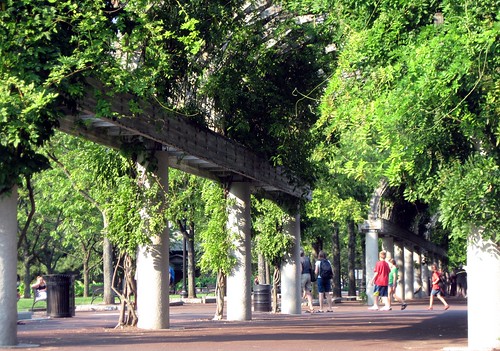A modest set of community principles for the President's second term

Posted November 7, 2012 at 1:27PM
Finally, finally, the US election is behind us. Voters have spoken in national, state, and local races, and it is time for those who lead and govern to return to the business of leading and governing. I would also like to think that those of us who fought so hard for the candidates and principles in which we believed can now set aside our animosity and work together toward the common goods of peace, prosperity, and fairness, toward shared respect for life, liberty, and the pursuit of happiness.
But I’m not that naïve. Gracious, unifying speeches last night by former governor Romney and the president notwithstanding, politics has become a blood sport, one that is practiced full-time. What we used to think of as “the loyal opposition” has become openly disloyal obstruction constantly fueled with over-the-top rhetoric, and I for one do not see that abating. Our sharp-edged polarization is bad for the country and bad for the human spirit -- and downright terrible for anything resembling “community” -- but it is what we have.
So, realistically, what to do in the public arena, particularly in the federal government? I have a few principles that I believe the administration should follow in its second term when it comes to its approach to cities, communities, and a clean and healthy environment. They aren’t exactly rocket science, and in fact they are modest by intention. I am not among those wishful thinkers, including some of my friends and colleagues, who believe now is the time to swing left or that a more aggressive approach to reform is likely to succeed. It isn't.
These basics assume that public revenues will continue to be scarce, and political consensus as elusive as ever. But that does not mean that they aren’t important. Here they are:
- Continue the cooperation among federal agencies that assist communities. It really shouldn’t be considered all that innovative that
 HUD, EPA and the Department of Transportation now talk to each other and coordinate when they respond to local proposals for federal support. One would think the government would routinely make sure that funds are appropriately leveraged and being spent in complementary, rather than discordant, ways. But, until HUD secretary Donovan and DOT secretary LaHood announced a partnership built around a set of joint principles, and EPA soon joined, it simply hadn’t been done. While I wish these agencies had more budget to work with, even modest (by federal standards) coordinated planning grants to places like Denver’s South Lincoln neighborhood and Ranson, West Virginia make a big difference. When this is done over time in many places across the country, we all are better for it.
HUD, EPA and the Department of Transportation now talk to each other and coordinate when they respond to local proposals for federal support. One would think the government would routinely make sure that funds are appropriately leveraged and being spent in complementary, rather than discordant, ways. But, until HUD secretary Donovan and DOT secretary LaHood announced a partnership built around a set of joint principles, and EPA soon joined, it simply hadn’t been done. While I wish these agencies had more budget to work with, even modest (by federal standards) coordinated planning grants to places like Denver’s South Lincoln neighborhood and Ranson, West Virginia make a big difference. When this is done over time in many places across the country, we all are better for it. - It doesn’t really matter whether the consortium continues to be called the Partnership for Sustainable Communities. What matters is that interagency coordination and collaboration become a lasting part of the federal culture.
- But do continue to make modest investments in helping cities, towns, and regions bring planning and coding up to date. While some may question whether local planning should be a concern of the federal government at all, there’s a difference between federally directed planning outcomes (which are not appropriate under current law) and federal assistance to efforts initiated by localities who lack sufficient resources to do the job by themselves. Outdated plans and haphazard development patterns are economically inefficient, drain life from older communities, and aggravate pollution; these consequences transcend municipal and state boundaries and it is in the national interest to address them.
- Evaluate federal infrastructure spending according to the triple bottom line. Unless taxpayer dollars produce good return on investment in all three areas -- financially, for people, and with environmental soundness -- don’t spend them. While that still leaves a lot to interpretation, the principle is important. Significant damage can be done to one or another of those values if money is spent on the wrong things.
 Guide more discretionary investment to older neighborhoods and towns. As I have written repeatedly, nothing has been worse for the environment, the economy, and populations left behind than the rampant disinvestment of our traditional communities that took place in the latter decades of the 20th century. Sprawl flunks all three of the tests incorporated into the triple bottom line. Before wasting federal money on new infrastructure, we must restore and repair the old, especially in central cities where the prospects for multiple efficiencies are greatest.
Guide more discretionary investment to older neighborhoods and towns. As I have written repeatedly, nothing has been worse for the environment, the economy, and populations left behind than the rampant disinvestment of our traditional communities that took place in the latter decades of the 20th century. Sprawl flunks all three of the tests incorporated into the triple bottom line. Before wasting federal money on new infrastructure, we must restore and repair the old, especially in central cities where the prospects for multiple efficiencies are greatest.- Support conservation. Federal coordination should not be limited to HUD, DOT and EPA. At the same time that we are reviving deteriorated traditional neighborhoods, we should also be nourishing nearby natural areas and working lands both within and outside cities. The federal Departments of Agriculture and Interior, for example, have programs designed to help protect farmland and forests, along with valuable resource lands such as wetlands, threatened ecosystems, fisheries, and urban forests. These agencies, too, have contributions to make and advice to give to municipal and regional planning and thinking. We should be planning conservation and development together, not separately; when federal resources are brought to bear, these issues should not be neglected.
- Take a fresh look at MPOs. Neither the environment nor the economy respect jurisdictional boundaries, which is why regional thinking is so important. But most areas lack adequate legal and structural mechanisms for implementing meaningful regional approaches. Metropolitan planning organizations, which have assigned responsibilities under federal transportation and housing law (and, in some cases, additional responsibilities under state law) should be part of the solution. In fact, some are fantastic at what they do, exercising real leadership. But others languish. There are common complaints about the composition and distribution of influence within MPOs and the procedural rules that they follow. Their decisions frequently carry little legal authority. We should convene a commission to take a close look at how these potentially more important entities function and how they might be improved, with recommendations issued in time to be incorporated into the next major transportation bill.
Clearly, bolder reforms are also needed. But these can be followed even as we proceed under current law and with realistic budgets. What would you add, following the same constraints?
Related posts:
- A fiscal conservative's manifesto against sprawl (September 18, 2012)
- Nationwide data show how transportation costs hurt families, better planning can help (February 28, 2012)
- New HUD grants will help communities pursue sustainability (November 22, 2011)
- The importance of regional planning that matters (August 12, 2011)
- A very impressive two weeks for the federal sustainability partnership (October 22, 2010)
- We're losing an acre of farmland every minute, according to new data (October 4, 2010)
- It’s time to adjust to the new metropolitan reality (continued) (March 26, 2009)
Move your cursor over the images for credit information.
Please also visit NRDC’s sustainable communities video channels.

